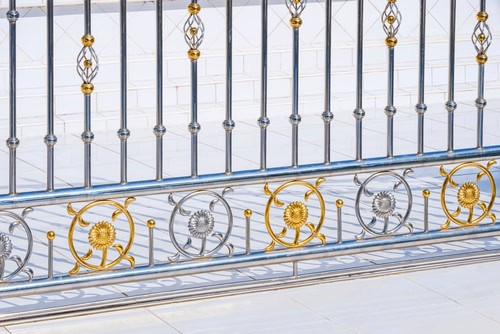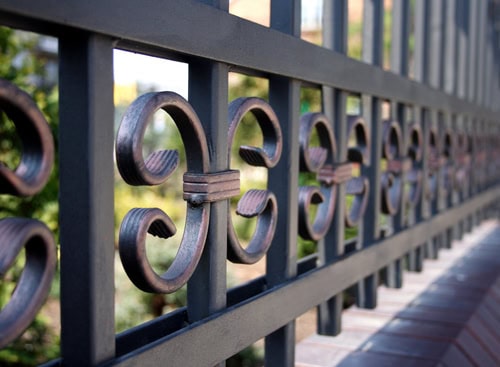
Customization Options for Aluminum Wrought Products
February 27, 2024
Advantages of Using Aluminum Railings for Stairs and Balconies
May 20, 2024Aluminum Wrought vs Steel: A Comparative Guide

Aluminum Wrought vs Steel A Comparative Guide
Aluminum Wrought vs Steel: A Comparative Guide. In the dynamic world of construction and manufacturing, the debate between using aluminum wrought and steel is ongoing.
This comparative guide delves deep into the attributes, applications, and environmental considerations of both materials, offering insights to make an informed choice for your projects.
The choice of materials is a fundamental aspect that affects the structural integrity, sustainability, and aesthetic appeal of any project.
Aluminum wrought and steel, each with its unique properties and applications, stand as popular choices in the field.
This guide aims to shed light on their differences, advantages, and considerations, guiding professionals and enthusiasts in their material selection process.
Understanding the Basics
Aluminum Wrought
Wrought aluminum, distinguished from its cast counterpart, is known for its enhanced properties obtained through mechanical processing and treatment.
This process improves its strength, ductility, and workability, making it a versatile material for various applications.
Aluminum wrought is celebrated for its lightweight nature, remarkable corrosion resistance, and excellent malleability, which allows it to be used in intricate designs and shapes.
Its non-toxicity and thermal conductivity further broaden its use across industries.
Steel
Steel, an alloy of iron and a small amount of carbon is renowned for its exceptional strength and durability.
The addition of other elements like manganese, chromium, and nickel can alter its properties, resulting in various types of steel with specific characteristics.
Steel’s versatility makes it indispensable in construction, automotive, and many other industries.
Its high tensile strength, resistance to wear and tear, and ability to withstand extreme conditions make it a reliable choice for demanding applications.
Physical and Mechanical Properties

Strength and Durability
Comparing the tensile strength and durability of wrought aluminum to steel, it’s evident that steel often holds the upper hand in raw strength.
However, wrought aluminum’s resistance to corrosion and its strength-to-weight ratio present compelling advantages, especially in applications where weight reduction is critical without significantly compromising durability.
Weight and Density
The significance of a material’s weight is paramount in industries like aerospace and transportation, where efficiency is directly tied to the material’s density.
Wrought aluminum, being significantly lighter than steel, offers fuel efficiency and easier handling, which can be critical in design and transportation costs.
Corrosion Resistance
Corrosion resistance is a crucial factor in material selection, especially for projects exposed to harsh environmental conditions.
Wrought aluminum naturally forms a protective oxide layer when exposed to the atmosphere, providing inherent protection against corrosion.
Steel, although susceptible to corrosion, can be treated with various coatings to protect against rust and degradation.
Environmental Impact

Sustainability and Recycling
Both wrought aluminum and steel boast high recyclability, which enhances their sustainability profile.
Aluminum wrought, in particular, requires less energy to recycle than to produce from raw bauxite, significantly reducing its environmental impact.
Steel’s recyclability also contributes to a lower environmental footprint, as recycled steel uses less energy and resources than producing new steel from iron ore.
Carbon Footprint
The production processes of both materials have implications for their carbon footprint.
While steel production is energy-intensive and associated with higher CO2 emissions, advancements in technology and increased recycling efforts have begun to mitigate these impacts.
Aluminum production is also energy-intensive, particularly in the smelting process, but its recyclability and lower weight, leading to energy savings in product use, help offset these initial environmental costs.
Cost Considerations

Initial Costs and Availability
The market prices of wrought aluminum and steel fluctuate based on global supply and demand, production costs, and energy prices.
Generally, aluminum tends to be more expensive due to the complexities involved in its production and refinement.
However, its durability and lower maintenance requirements can make it a cost-effective choice over the project’s lifespan.
Maintenance and Lifecycle Costs
Considering maintenance and lifecycle costs is essential. Steel may require more intensive maintenance routines, including painting and protection against corrosion, which can add to the total cost of ownership.
Wrought aluminum, with its natural corrosion resistance and durability, often presents lower long-term maintenance costs, making it an attractive option for many projects.
Applications and Industry Uses
Construction and Infrastructure
In construction, the choice between wrought aluminum and steel often comes down to the project’s specific requirements.
Wrought aluminum finds use in architectural elements where aesthetics, weight, and resistance to corrosion are priorities, such as in façades, roofing, and window frames.
Steel, with its superior strength, is preferred in structural components that require high load-bearing capacity, including beams, columns, and reinforcements.
Transportation and Automotive
The transportation and automotive industries significantly benefit from both materials.
Wrought aluminum is increasingly used in automotive and aerospace manufacturing to reduce weight, enhance fuel efficiency, and lower emissions.
Steel continues to be used in these industries for components requiring high strength and durability, such as in chassis and structural frames.
The balance between weight reduction and safety has led to innovative uses of both materials in hybrid structures that maximize the advantages of each.
Consumer Products
The versatility of wrought aluminum and steel extends into consumer products, where their distinct properties are leveraged to meet diverse needs.
Wrought aluminum is favored for its lightweight and aesthetic appeal in electronics, kitchenware, and furniture.
It allows for sleek, modern designs combined with functionality and durability. Steel’s robustness and resistance to wear make it ideal for appliances, tools, and outdoor equipment, ensuring longevity and reliability.
Aesthetic and Practical Considerations

Aesthetic Appeal
The choice between wrought aluminum and steel often involves aesthetic considerations.
Wrought aluminum offers a clean, contemporary look with its natural silver-white finish and can be easily anodized to a variety of colors, enhancing its appeal in design-forward applications.
Steel, with its intrinsic strength, can be finished in numerous ways (painting, powder coating) to achieve desired looks but often conveys a more industrial aesthetic.
Workability and Fabrication
Wrought aluminum is renowned for its workability, being easy to cut, weld, and form into complex shapes.
This makes it a preferred material in applications requiring detailed, intricate designs without sacrificing structural integrity.
Steel, while more challenging to work with due to its hardness, provides unparalleled strength and durability, making it suitable for heavy-duty applications.
Advances in fabrication technology have eased the working of steel, broadening its use in complex designs.
Safety and Compliance
Fire Resistance
When it comes to fire resistance, steel has a higher melting point than wrought aluminum, making it more suitable for applications where fire safety is a concern.
The structural integrity of steel at high temperatures ensures stability and safety in fire situations, making it a critical material in building and infrastructure projects.
Health and Safety Standards
Both materials must comply with health and safety standards, especially in construction and manufacturing settings.
Handling and fabricating these materials require adherence to safety protocols to prevent injuries and health issues.
Wrought aluminum and steel both have specific considerations for safe handling, cutting, welding, and installation, with guidelines established to protect workers and end-users.
Aluminum Wrought vs Steel: A Comparative Guide – Conclusion

The comparison between wrought aluminum and steel reveals a landscape of diverse applications, environmental considerations, and cost implications.
Each material boasts unique properties that make it suitable for specific uses, from lightweight, corrosion-resistant aluminum in design-centric projects to strong, durable steel in structural applications.
The decision to choose wrought aluminum or steel should be guided by a comprehensive understanding of these materials’ benefits, limitations, and the specific requirements of the project at hand.
With careful consideration, architects, engineers, and designers can leverage the strengths of wrought aluminum and steel to achieve innovative, efficient, and sustainable outcomes in their work.
Are you seeking a professional and reliable aluminum wrought gate or window installation service in Singapore? Contact us today!



